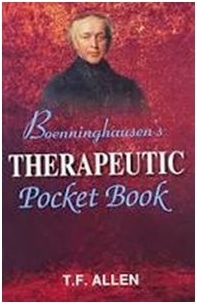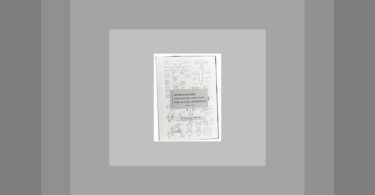Boenninghausen’s Therapeutic Pocket-Book
Reviewed in The Homoeopathic World – Volume 26, 1891
– Editor J.H. Clarke MD
Published by B Jain Publishers (2003)
ISBN 10: 8131902994 ISBN 13: 9788131902998
503 Pages

Among the followers of Hahnemann there have been few such accurate and successful prescribers and few such intelligent and profound students of the materia medica as Boenninghausen. But Boenninghausen possessed another gift in addition to those of the prescriber and the student; he had the faculty of putting his experience in such a form as to make it available for all other labourers in the same field.
No one has done more than he to make the homeopathic materia medica workable and intelligible* Doubtless provings in the healthy form the foundation of the materia medica but the test of clinical experience must be applied in order to provide a critical commentary upon and amplication of the provings. This is the work which Boenninghausen has accomplished, and its embodiment is to be found in the volume before us.
One of the greatest difficulties in finding in the materia medica the corresponding symptom to that met with in the patient lies in the form in which the prover and the patient respectively express their sensations. One may have a burning pain, and the other may say he feels as if he were being branded with a hot iron. Unless the prescriber can mentally reduce the one and the other to what may be called the lowest common denominator, he is very likely to miss the correspondence.
In the Pocket-Book Boenninghausen has reduced the materia medica to its lowest denominator. He has grouped under the same headings all the medicines that have any particular symptom in common, however variously expressed by provers. But he has done more than this.
All the symptoms of a medicine have not the same value. Two medicines may affect the same part in the same way, but one in a much lower degree of intensity than the other. The degree of affinity is discovered in two ways—either by the frequency and intensity of the effect on the prover, or on the certainty with which the same affection is removed in the sick.
Boenninghausen has marked the value of each symptom as produced by the different medicines by differences of type. Under each heading he gives a list of the remedies which relate to it, and by printing the names of the medicines in five different forms of type he distinguishes the emphasis to be attached to each. It is this element in the work which renders it especially useful in the study of the materia medica.
The seventh part of the work, which deals with the relationships of remedies one to another, is also of great service in this study.
The work is divided into seven parts. Part I. gives the symptoms of the Moral and Intellectual Faculties; Part II. deals with the Seat of the Symptoms, Organs and their Functions (following the Hahnemannian schema); Part III, Sensations and Morbid States— (a) general, (b) in glands, ( c) in bones, (d) in skin; Part IV., Sleep and Dreams; Part V., Circulation ana Fevers; Part VI., Conditions of Aggravation and Amelioration; and, lastly, Part VII., Drug Affinities or Relationships.
From this it will, appear that the Pocket-Book is in its way a very complete repertory of the materia medica. It cannot take the place of repertories of special parts, but it has a place of its own which no other work can fill.
Of course, it requires care and judgment in the using, but those who are best acquainted with it find it indispensable. The author’s preface should be studied most attentively. The case he gives by way of example, in which Valerian was the remedy, though at first sight Pulsatilla or China seemed strongly indicated, is eminently instructive as well as illustrative of the method of using the work.
For many years the Pocket-Book has been out of print, and only with the greatest difficulty obtainable at all. Hence a generation of homeopaths have arisen who know not Boenninghausen.
Dr. T. F. Allen has now provided the remedy for this unfortunate state of things. In the dainty little volume before us—a veritable pocket-book—clearly printed on rolled paper, strongly bound in limp Russia, every homeopathic practitioner may now possess the classic work of Boenninghausen.
Dr. Allen has done his editing most judiciously. The temptation must have been strong to overload the work with new matter, but Dr. Allen has kept it very much to its old limits; he has only added such matter as has stood the test of experience.
We fully share Dr. Allen’s confident expectation, that this little book will serve to give an impetus to a due study of symptomatology, from which alone the most successful results at the bedside are to be obtained.
. In conclusion, we congratulate alike the editor, the publishers, the homeopathic profession, and, we may add, the manes of the author, on the appearance of this much-needed volume.
* Boenninghausen’s Therapeutic Pocketbook, for Homeopathic Physicians- to use at the Bedside in the Study of the Materia Medica . A New American Edition. By Dr. Timothy Field Allen. Philadelphia: Hahnemann Publishing House. London, Homeopathic Publishing Company, 12, Warwick Lane, E.C. 1891.





